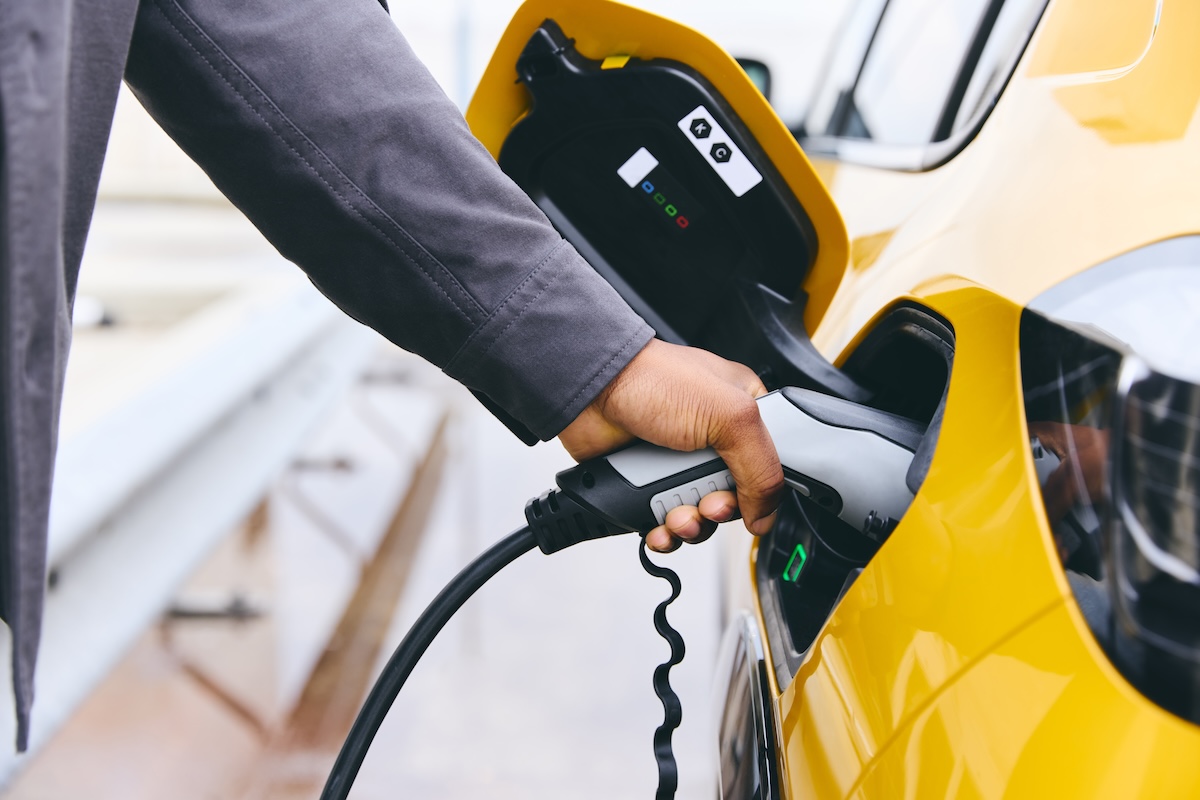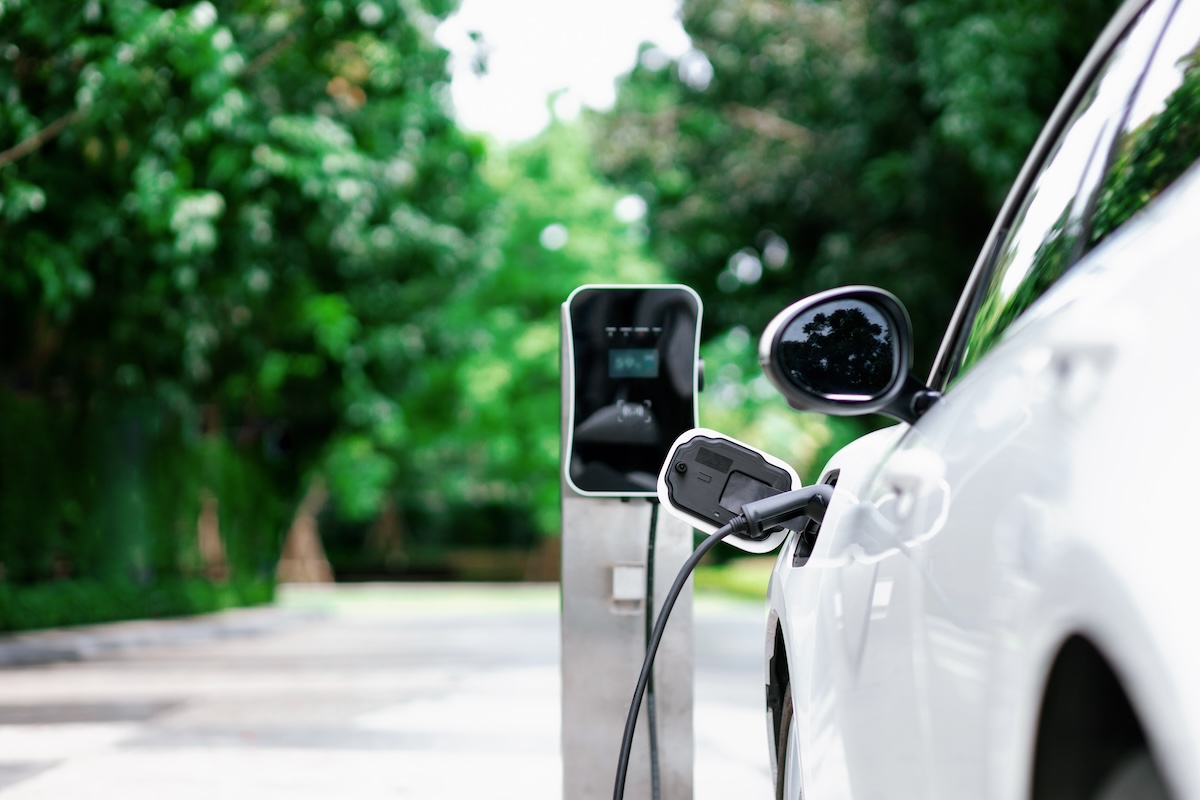As we explained in How Do I Charge an Electric Car?, there are three different levels of electric vehicle charging, all of which charge at different rates.
Throughout this article, we’ll use a Nissan Leaf Plus with the largest possible battery pack as our example. A standard Leaf comes with a 40 kilowatt-hour (kWh) battery capacity. The Leaf Plus has a 62 kWh battery pack. Your mileage, as the ads say, may vary because you might have a vehicle with larger or smaller battery pack.
Level 1:

Every EV, including the Nissan Leaf Plus, comes equipped with a Level 1 charger. It’s the most basic method of charging an electric vehicle. A Level 1 charger requires no additional wiring, and no upgraded electrical outlets. You simply plug the charger into a standard 120-volt wall outlet and plug the opposite end into the car’s charging connector. The vehicle’s battery pack will then start charging automatically.
A Level 1 charger isn’t designed to be your only mode of charging an EV. The Nissan Leaf microsite explains it this way: “Need a charge in a pinch? The Nissan LEAF features a standard 120V charging cable, which allows you to temporarily plug into a standard 120V outlet for a Level 1 charge. It’s the slowest option, but it lets you add some range wherever you have access to electricity.”
While Nissan provides some estimates on how long it takes to charge using other levels of charging, it doesn’t with the Level 1 charger, but here’s a good starting point: A Level 1 charger will get you roughly 5.9 miles of range for every hour of charging. To charge our 62 kWh Nissan Leaf Plus from 0 percent to 100 percent charge, at a socket output of 1.8 kW, would take 38 hours and 16 minutes.
If you have that kind of time—for example, if you’re retired, work from home, or don’t have a very long commute—a Level 1 charger may be fine for you. Better yet, if you have a plug-in hybrid like the Jeep Wrangler 4xe, a Level 1 charger might be all you need, since you can go from 0 percent to 100 percent charge in about seven hours, a convenient span if you have a PHEV to plug in overnight.
But we’ve attempted to charge cars like the Kia Soul EV and a Jaguar I-PACE, both of which have larger batteries than a plug-in hybrid, using a Level 1 charger, and it’s exceedingly time-consuming. An overnight charge on a Level 1 charger would get you only about 50 miles. That’s ok if you’re just trying to top off the battery in your electric car, but it’s not going to work for most people as a long-term solution.
Level 2:

Most of the public charging stations you’ll find around the country are Level 2 chargers. They have the ability to charge at a rate of 7.2kW, but our Leaf Plus limits the charging speed to 6.6kW. Going from 0 percent to 100 percent with a Level 2 charger would take 10 hours and 26 minutes, which sounds a whole lot more reasonable than the nearly 40 hours it would take using a Level 1 charger.
If you're home charging, the Level 2 charger is probably going to be your preferred and most frequent mode of EV charging. There are some things to sort out before you decide to purchase a Level 2 charger, though:
Do you own or rent your home? If you own a single-family, detached house, you have a lot less to think about because you’re in control of your electric supply. If you’re in a condominium, there’s a lot more to consider. If you have a garage, it’s probably not an issue, but if you just have a parking spot, the chances of having a charger wired get slimmer. If you rent, you’ll need to discuss the issue with your landlord.
Do you have the spare capacity on your electric panel to add a 240-volt, dedicated circuit? If you live in a modern house or one that’s been upgraded with 200-amp service, you’re likely fine, but if you live in an old house with 60-amp service, you’re going to have to upgrade your service first.
Do you want to hard-wire the charger, or plug it in? Level 2 chargers can be permanently hard-wired in the location you choose, or you can simply have a 240-volt outlet installed, and plug into it the way you’d plug into any other wall socket. Plug-in Level 2 chargers are more convenient because you can unplug them and plug them into a conventional dryer outlet at someone else’s house when you’re traveling, for example. But plug-in Level 2 chargers can only deliver 40-amps or less. That’s not an issue now, mostly because cars like the Nissan Leaf Plus limit charging to 6.6 kW. But as larger vehicles with much bigger battery packs arrive, this restriction will be something to consider.
Do you want a basic charger or a smart charger? Basic chargers simply charge the battery. Smart chargers have a lot more functionality, connect to WiFi, and can help you program charge times (which can help you charge only when electricity is cheapest), and monitor usage. That’s nice, but a lot of that functionality is built into the apps provided by the auto manufacturer, too, so you can save quite a bit of money just by choosing a simpler charger.
Do you need an outdoor charger? If you don’t have a garage, you’re going to need a Level 2 charger that’s rated to be outdoors. Chargers are rated by the National Electrical Manufacturers Association (NEMA). Most public charging stations are rated NEMA 3 or NEMA 4, both of which are acceptable to use outside as a home charger. NEMA 3 means “weather-resistant,” suggesting that the charger will protect against falling dirt, windblown dust, and rain, sleet, and snow. NEMA 4 is “watertight,” meaning it can be blasted with a hose at 10 feet for five minutes. Unless you live at a lighthouse on the Maine coast, you can probably get away with a NEMA 3 rated home charger.
The good news is that the price has fallen dramatically for Level 2 chargers. At the low end, you can get a very basic Level 2 charger for about $425.
Level 3:

These DC Fast Chargers are 400V monsters that can fill an empty Nissan Leaf Plus in about 90 minutes, or about 150 miles of range per hour of charging. Now we’re talking.
Unless you’re Elon Musk with a fleet of Tesla models, you’re probably not going to be installing a Level 3 fast-charging station at your house. They require commercial-level power delivery, and the charging system itself is prohibitively expensive. These Level 3 EV charging stations are typically found at gas stations, highway service plazas, car dealerships, or Tesla Supercharger stations.
At a rate of 90 minutes for a full charge from empty, that’s still a long time to be hanging around eating Ding Dongs from the Service Plaza convenience store. But the idea isn’t necessarily to get a full charge. They can be helpful to top up a battery as you get closer to home. Or, say you’re reaching zero range at the Charlton Plaza on the Massachusetts Turnpike, 54 miles west of the city of Boston. At 150 miles per hour of charging, you could get enough of a charge to get to Boston in about 20 minutes.
There are other considerations that influence charging time. When it’s cold, for example, charging times can be longer, but as EVs get more advanced, they can pre-condition the battery to accept a charge at a faster rate.


